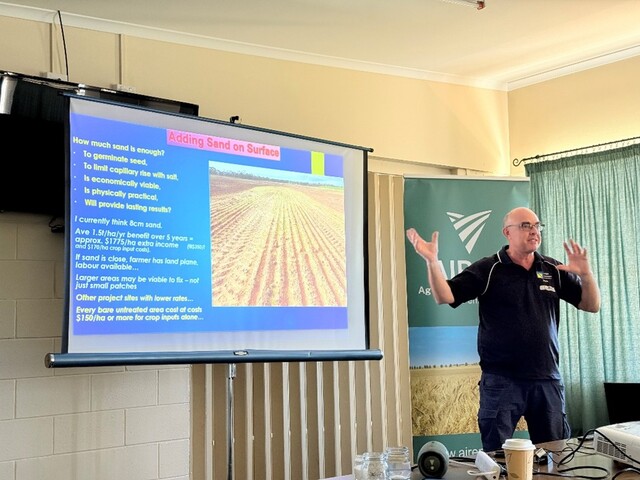Eyre Peninsula farmers have new tactics to tackle dry saline soils this season, plus the latest information on how to apply variable rate technology to their cropping plans, thanks to workshops held across the district.
Ag Innovation and Research Eyre Peninsula (AIR EP) held three Soils and Nutrition Workshops that delved into tools and tactics for managing dry saline soils, as well as introducing the basics of variable rate technology (VRT).
More than 40 farmers, advisors, researchers and industry representatives attended events in Kimba, Minnipa and Ceduna.
AIR EP executive officer Naomi Scholz said the workshops aimed to equip farmers with proven, cost-effective soil and fertiliser management practices to build resilience and yield potential.
“Farmers on the EP face specific challenges with soil management and looking after dry saline soils is one area that can be difficult,” she said.
“The workshops gave growers and other industry leaders a detailed understanding of how saline soils function and their impact on plant growth. The sessions also detailed some of the effective soil management strategies available.
“It was a great opportunity for farmers to ask our presenting experts questions about the specific issues they’re seeing out in the paddock, and to share the successes and challenges they’ve had with different management techniques.”
Ms Scholz said the VRT session was helpful in demystifying how farmers could apply this approach to their own properties to increase farm operation efficiencies and support soil management and crop growth.
“The feedback that we’ve had so far was that farmers left the workshops with a better understanding of their properties’ soil constraints and potential, had learnt how to zone paddocks easily for variable rate application, and felt confident that they could implement the basics of VRT.”
The dry saline soils management sessions were led by Dr Chris McDonough of Insight Extension for Agriculture.
They covered how saline soils function, along with management strategies available, what worked well, and what should be avoided in some rainfall situations and with certain soil types.
Strategies covered that farmers may consider in managing dry saline soils included:
• Mulching soils through spreading sand, straw or chaff during dry summer periods to reduce evaporation and wicking of salts to the surface.
• Retaining as much ground cover as possible on vulnerable areas.
• Removing livestock from dry saline soils.
Dr Sean Mason from Agronomy Solutions led the sessions on VRT, which emphasised the need for farmers to know the soil types and pH across their paddocks.
Top tips for farmers looking to apply VRT on-farm included:
• Knowing what the unique zones are in each paddock in order to respond with the best inputs for those areas.
• Combining Normalised Difference Vegetation Index (NDVI) mapping and Google Earth maps to identify paddock soil types, then layering soil pH and NDVI maps to identify areas of phosphorous deficiency.
• Investigating poor performing paddock areas and using high-performing areas as a benchmark for comparison.
• Conducting phosphorous strip trials on-farm to help determine application rates and set an input budget.
AIR EP continues its program of events this month with a series of workshops across the region introducing farmers to the basics of carbon farming.

